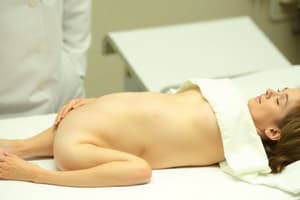Podcast
Questions and Answers
Which of the following accurately describes the Glasgow Coma Scale (GCS) in assessing LOC?
Which of the following accurately describes the Glasgow Coma Scale (GCS) in assessing LOC?
- It focuses solely on a patient's verbal response to questions.
- It categorizes patients into alert and unresponsive without detailed evaluation.
- It evaluates alertness based on a patient's motor response, verbal response, and eye-opening. (correct)
- It measures only eye movement in response to stimuli.
What does a capillary refill time greater than 2 seconds indicate?
What does a capillary refill time greater than 2 seconds indicate?
- Possible venous insufficiency.
- Indications of shock or peripheral vascular disease. (correct)
- Healthy circulation in the extremities.
- Normal peripheral perfusion.
What condition is characterized by the broadening and thickening of the fingers and nails due to chronic hypoxia?
What condition is characterized by the broadening and thickening of the fingers and nails due to chronic hypoxia?
- Pedal edema.
- Digital clubbing. (correct)
- Subcutaneous emphysema.
- Tactile fremitus.
How is pedal edema quantitatively graded?
How is pedal edema quantitatively graded?
What does an increase in tactile fremitus during chest examination suggest?
What does an increase in tactile fremitus during chest examination suggest?
Which abnormal percussion sound indicates the presence of fluid or solid tissue in the lungs?
Which abnormal percussion sound indicates the presence of fluid or solid tissue in the lungs?
What condition is indicated by a tracheal deviation away from the affected side?
What condition is indicated by a tracheal deviation away from the affected side?
Which spinal abnormality is characterized by a lateral curvature that may affect lung function?
Which spinal abnormality is characterized by a lateral curvature that may affect lung function?
What is the normal ratio of the width of the chest to its depth in adults?
What is the normal ratio of the width of the chest to its depth in adults?
What might unequal expansion of the chest during inspiration suggest?
What might unequal expansion of the chest during inspiration suggest?
Flashcards are hidden until you start studying
Study Notes
Level of Consciousness (LOC)
- LOC is a key assessment for evaluating a patient's alertness and cognitive response.
- Categorized into alert, lethargic, obtunded, stuporous, and comatose states.
- The Glasgow Coma Scale (GCS) evaluates LOC based on eye-opening, verbal response, and motor response.
Extremities Assessment
- Involves assessing circulation, motion, and sensation in hands and feet.
- Normal findings include warm, dry skin, full range of motion, and symmetrical muscle strength.
- Abnormal findings may show cold extremities, weak pulses, or loss of sensation, indicating potential circulation issues.
Digital Clubbing
- Clubbing is the thickening of fingers and nails, often indicating chronic hypoxia.
- Common conditions leading to clubbing include COPD, lung cancer, and congenital heart diseases.
Capillary Refill
- A test for assessing peripheral perfusion by pressing on the nail bed and measuring time for color return.
- Normal capillary refill time is less than 2 seconds, while delayed refill (over 2 seconds) can indicate shock or peripheral vascular disease.
Pedal Edema
- Swelling in lower extremities, often a result of heart failure or venous insufficiency.
- Graded from +1 to +4 based on depth and persistence of pitting after pressure application.
Conditions That Cause Abnormal Assessment
- Heart failure can lead to pedal edema and jugular venous distention (JVD).
- Lung diseases such as COPD or pneumonia may cause digital clubbing, altered tactile fremitus, or abnormal percussion findings.
Tactile Fremitus
- A chest wall vibration felt during speech, often assessed with "99."
- Increased fremitus may indicate lung consolidation (e.g., pneumonia), while decreased fremitus may result from pneumothorax or pleural effusion.
Subcutaneous Emphysema
- Condition characterized by trapped air under the skin, commonly due to trauma or chest tubes.
- Present as a crackling sensation when pressing the skin, resembling bubble wrap.
Percussion
- Normal percussion results in a resonant sound, indicating air-filled lungs.
- Dullness suggests fluid or solid tissue, often seen in pleural effusion or pneumonia.
- Hyperresonance indicates overinflation of lungs, as in emphysema or pneumothorax.
Spinal and Chest Abnormalities
- Kyphosis refers to abnormal forward spine curvature, affecting respiratory function in elderly patients.
- Scoliosis involves a lateral curvature of the spine, potentially compromising lung function.
Jugular Venous Distention (JVD)
- Increased venous pressure in the neck that is prominent in right-sided heart failure.
- Assessment performed with the patient elevated at a 45-degree angle; distended veins indicate higher central venous pressure.
Chest Expansion
- Normal chest expansion should be equal on both sides during inspiration.
- Unequal expansion indicates possible conditions like pneumothorax, pleural effusion, or lung collapse.
Anterior-Posterior (A/P) Diameter
- Normal chest width to depth ratio is about 2:1.
- In conditions like emphysema, a barrel chest appearance with a 1:1 ratio suggests hyperinflation.
Tracheal Deviation
- The trachea shifts towards the affected side in atelectasis or lung collapse.
- It moves away from the affected side in conditions like tension pneumothorax or large pleural effusion.
Studying That Suits You
Use AI to generate personalized quizzes and flashcards to suit your learning preferences.




